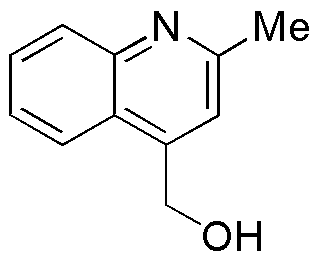(2-Methyl-quinolin-4-yl)methanol is widely utilized in research focused on:
- Pharmaceutical Development: This compound serves as a valuable intermediate in the synthesis of various pharmaceuticals, particularly those targeting neurological disorders, enhancing drug efficacy and specificity.
- Biochemical Research: It is used in studies investigating enzyme inhibition and receptor binding, providing insights into cellular processes and potential therapeutic targets.
- Material Science: The compound can be incorporated into polymer matrices, improving the mechanical properties and thermal stability of materials used in coatings and composites.
- Fluorescent Probes: Its unique structure allows for the development of fluorescent probes for bioimaging applications, aiding in the visualization of cellular components in live cells.
- Environmental Monitoring: It can be utilized in the detection of pollutants, serving as a marker in environmental studies to track chemical changes in ecosystems.
General Information
Properties
Safety and Regulations
Applications
(2-Methyl-quinolin-4-yl)methanol is widely utilized in research focused on:
- Pharmaceutical Development: This compound serves as a valuable intermediate in the synthesis of various pharmaceuticals, particularly those targeting neurological disorders, enhancing drug efficacy and specificity.
- Biochemical Research: It is used in studies investigating enzyme inhibition and receptor binding, providing insights into cellular processes and potential therapeutic targets.
- Material Science: The compound can be incorporated into polymer matrices, improving the mechanical properties and thermal stability of materials used in coatings and composites.
- Fluorescent Probes: Its unique structure allows for the development of fluorescent probes for bioimaging applications, aiding in the visualization of cellular components in live cells.
- Environmental Monitoring: It can be utilized in the detection of pollutants, serving as a marker in environmental studies to track chemical changes in ecosystems.
Documents
Safety Data Sheets (SDS)
The SDS provides comprehensive safety information on handling, storage, and disposal of the product.
Product Specification (PS)
The PS provides a comprehensive breakdown of the product’s properties, including chemical composition, physical state, purity, and storage requirements. It also details acceptable quality ranges and the product's intended applications.
Certificates of Analysis (COA)
Search for Certificates of Analysis (COA) by entering the products Lot Number. Lot and Batch Numbers can be found on a product’s label following the words ‘Lot’ or ‘Batch’.
*Catalog Number
*Lot Number
Certificates Of Origin (COO)
This COO confirms the country where the product was manufactured, and also details the materials and components used in it and whether it is derived from natural, synthetic, or other specific sources. This certificate may be required for customs, trade, and regulatory compliance.
*Catalog Number
*Lot Number
Safety Data Sheets (SDS)
The SDS provides comprehensive safety information on handling, storage, and disposal of the product.
DownloadProduct Specification (PS)
The PS provides a comprehensive breakdown of the product’s properties, including chemical composition, physical state, purity, and storage requirements. It also details acceptable quality ranges and the product's intended applications.
DownloadCertificates of Analysis (COA)
Search for Certificates of Analysis (COA) by entering the products Lot Number. Lot and Batch Numbers can be found on a product’s label following the words ‘Lot’ or ‘Batch’.
*Catalog Number
*Lot Number
Certificates Of Origin (COO)
This COO confirms the country where the product was manufactured, and also details the materials and components used in it and whether it is derived from natural, synthetic, or other specific sources. This certificate may be required for customs, trade, and regulatory compliance.


